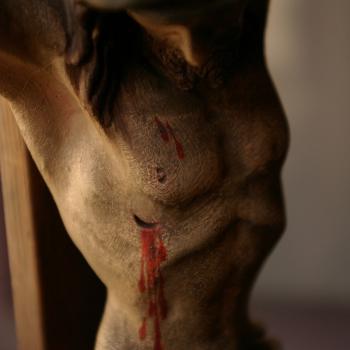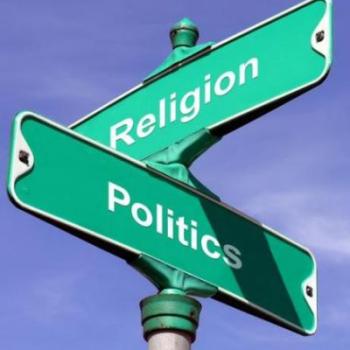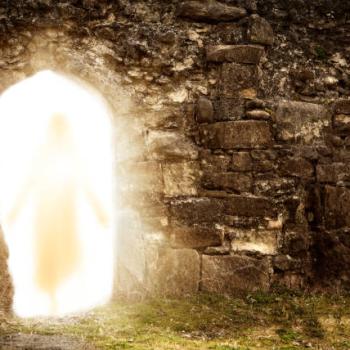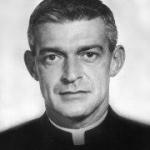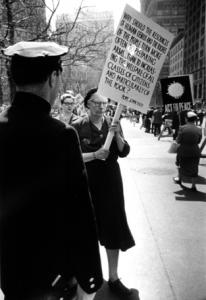
The 1950’s was a scary, insane time. I didn’t know then how insane it was, but I knew how scary. My elementary school years pretty much coincided with the “duck and cover” era of civil defense. That phrase told us what to do if there ever happened to be a bright flash in the sky. That would, of course, indicate a nuclear bomb blast nearby. Schools had civil defense drills like fire drills, except instead of going outside we ducked under our desks. I don’t feel any lasting psychological trauma from that experience, but to this day I have a picture in my mind of a person (me perhaps) whose eyes melted after instinctively turning toward that light.
Of course, we were told not to do that. We got many other instructions, like stocking a room in the basement for a fallout shelter. It all supporting the fiction that America could survive a nuclear war. That’s what the 17 sane people in the title refused to believe, and for that they went to jail.
1955 civil defense protest
Dorothy Day, iconic figure of the Catholic Worker Movement, was one of the 17. Pope Francis added to her just fame (or infamy) by featuring her along with two other peace and justice advocates, Thomas Merton and Martin Luther King, Jr., in his 2015 address to Congress.
In the mid to late 1950’s nationwide civil defense drills were taking place yearly. The State of New York had made it a misdemeanor offense not to take cover during these drills, the next of which would occur on June 15, 1955. A Catholic Worker associate of Day’s, Ammon Hennacy, had been a regular protester since before World War I. He spent that war in prison for resisting the draft. He was, in chronological order, a socialist, conscientious objector, Christian pacifist and anarchist (after reading the Bible in prison), Catholic convert, and finally “non-church Christian.”
In 1955 Hennacy convinced Day and “a small group of other pacifists and anarchists” to break the law with a protest at City Hall Park on the day of the civil defense drill. Arrested, they pleaded guilty, receiving a suspended sentence. The protesters did, however, spend jail time for other protests, including a month for sitting out the 1957 drill. In 1961 the annual protest drew a crowd of thousands, and the New York legislature discontinued the drills.
Perhaps now we’re a little saner in one respect than we were in the 50’s. We no longer dream of surviving a nuclear war. A former neighbor has a sump pump where there had been a fallout shelter. But the risk of a nuclear conflagration and the moral hazard of possession of weapons of mass destruction continues.
Catholic teaching on nuclear deterrence
Catholic Church teaching on nuclear deterrence has evolved toward increasing urgency. Actual use of a nuclear weapon against a populated area was condemned by Vatican II and Pope John XXIII. Then and up to now, school children have been learning the lies and mythical attempts to justify Hiroshima and Nagasaki. (See my post “Hiroshima and Nagasaki: Lamentation, Repentance, and Amendment.” Pope John Paul II accepted deterrence, the threat of assured mutual destruction, as a “step on the way toward a progressive disarmament.” Partial disarmament did occur but stalled in the 2000’s and went in reverse during the Trump years.
Ambiguity about the morality of deterrence abounded. One could never morally intend to use a nuclear weapon, even in response to an attack; but one had to convince the other party that one would. In addition, the Church decried the extravagant sums spent on weapons of all kinds, including weapons of mass destruction. It was money that could addressed underlying causes of conflict and the miseries of humanity.
Finally, given the slow to non-existent pace of disarmament, Pope Francis declared in 2019,
The use of atomic energy for purposes of war is immoral, just as the possessing of nuclear weapons is immoral.
Dorothy Day and the other 16 civil defense protesters would have called that plain sanity.
Image credit: Marquette University Archives




